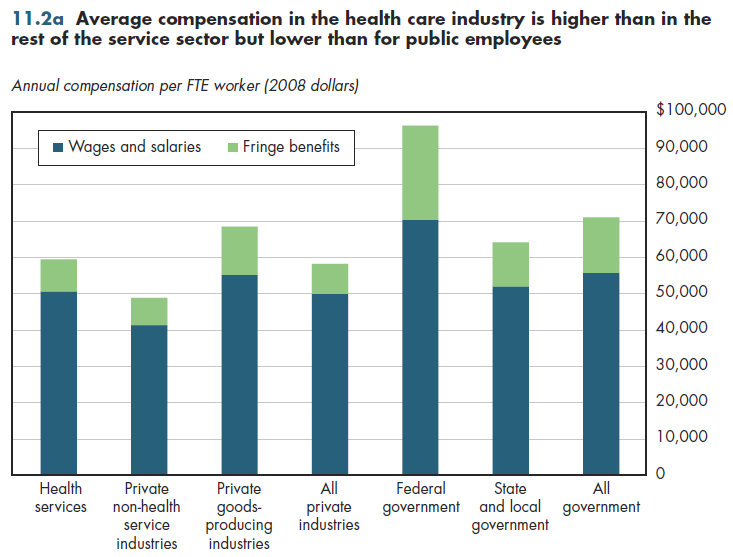Download PowerPoint versions of both figures.
Inside Collection (Textbook): Chapter 11: Personal Incomes and Health Care
11.2 Employee Compensation in Health Services Is Slightly Higher than All Workers Average
Summary: Employee compensation in the health services industry is much more than the average for other service industries but only slightly more than the average for all workers.
In the health services industry, the average compensation per FTE worker is more than $10,000 higher than for other workers in the service industry (figure 11.2a). It is lower than compensation in private goods-producing industries but slightly higher than the average for all private-sector workers. Both higher cash payments and fringe benefits contribute to the health care's margin of advantage.

Because detailed data are not available, these numbers exclude workers in the pharmaceutical and medical device industries. They also do not count government workers who might be employed in hospitals or other government-owned facilities. However, average compensation for all types of government workers is much higher than in the private sector (figure 11.2a, right axis). Therefore, inclusion of public sector health workers might increase the health industry average overall rather than reduce it. This is not certain because some of the difference in public versus private compensation relates to differences in the skill mix used in each sector.
The average compensation for health services masks some sizable differences across different parts of the industry. Average compensation for nursing and residential facilities is only approximately half the level seen in ambulatory health care services such as physicians' offices (figure 11.2b). In the former facilities, a relatively large portion of the workforce is performing custodial care that requires less skill and training than is required for many of the highly specialized personnel used in hospitals, for example.

Currently, one of every nine private employees works in the health care industry, a fraction that the BLS projects will grow over the next decade. Of the 12.2 million FTE private workers in the health sector in 2008, 40 percent work in ambulatory health care services, slightly more than 30 percent work in hospitals, and the remainder work in nursing homes and residential care facilities. It is somewhat more difficult to forecast health services employment under the health reform law. Total health spending is expected to rise. However, stringent limitations on Medicare payments, for example, have raised the prospect that some health facilities will be forced out of business altogether.
Downloads
References
- Author's calculations.
- Department of Commerce. Bureau of Economic Analysis.
Collection Navigation
- « Previous module in collection 11.1 Rising Health Costs Hindered Growth in American Workers' Earnings
- Collection home: Chapter 11: Personal Incomes and Health Care
- Next module in collection » 11.3 Employee Compensation in Ambulatory Health Sector Grew Slowly
Content actions
Give feedback:
Download:
Add:
Reuse / Edit:
Twin Cities Campus:
- © 2012 Regents of the University of Minnesota. All rights reserved.
- The University of Minnesota is an equal opportunity educator and employer. Privacy
- Last modified on Sep 26, 2013 2:09 pm -0500








